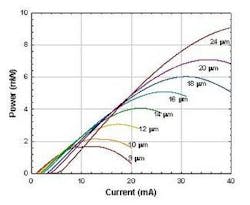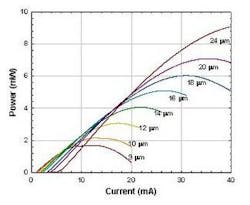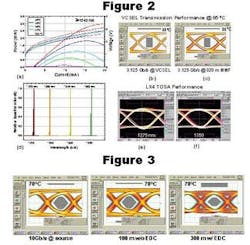Long-wavelength VCSELs ready for new applications
Julian Cheng, Chan-Long Shieh, Wenbin Jiang, and H.C. Lee
E2O Communications Inc.
Figure 1 summarizes the room-temperature CW lasing characteristics of a 1.32-micron VCSELs based on the new technique as a function of device size. The peak power ranges from 2.2 mW for a 10-micron-diameter active-area device to 9.2 mW for a 24-micron-diameter device at room temperature, and from 1.2 mW to 2.5 mW at 70 degrees C.
Application benefits
The LW-VCSEL technology has demonstrated its applicability to several potentially significant new markets. The wavelength flexibility of the AlInGaAs VCSELs makes them uniquely well-suited for WDM applications, such as the four-wavelength 10GBASE-LX4 CWDM solution for 10-Gigabit Ethernet (10GbE).
The insertion of LW-VCSEL technology into 10GBASE-LX4 applications provides a significant cost advantage over modules that are currently based on DFB lasers. Individual VCSELs for each wavelength channel, whose typical dc characteristics are shown in Figure 2(a), have demonstrated error-free transmission at 3.125 Gbits/sec through 320 m of conventional multimode fiber at temperatures up to 85 degrees C (Figures 2b-2c).
An experimental 10GBASE-LX4 XENPAK module was built using proprietary LW-VCSELs with four equally spaced wavelength channels in the 1275 nm to 1350 nm range (Figure 2d). Error-free transmission was achieved at the module level with each channel operating at 3.125 Gbits/sec and propagating through 300 m of multimode fiber for an aggregate data throughput of 10 Gbits/sec. Eye diagrams of two of the wavelength demultiplexed output channels are shown in Figure 2e and 2f, respectively.
Long-wavelength operation can also extend the reach of VCSELs in other 10-Gbit/sec applications, such as a single-channel 10GbE link spanning up to 300 m of multimode fiber. Conventional 10GbE links based on 850-nm VCSELs are limited to distances between 26 m and 82 m due to modal dispersion in different classes of legacy multimode fiber, as defined by the IEEE 802.3ae 10GbE standard. On the other hand, 10GbE links based on multimode LW-VCSELs have demonstrated error-free transmission over more than 110 m of conventional multimode fiber at operating temperatures up to 70 degrees C without electronic dispersion compensation (EDC). Furthermore, the transmission distance of the 10-Gbit/sec multimode link has been successfully extended to over 320 m of legacy multimode fiber at operating temperatures up to 70 degrees C without any errors by using a commercial EDC chip (Figure 3). Operation at temperatures above 70 degrees C should be possible by using a more optimized EDC device.
Dr. Julian Cheng is vice president of R&D at E2O Communications Inc. (Calabasas, CA). He received his Ph.D. from Harvard University, and has over 20 years of experience in optoelectronics and fiber-optic communications technology. He was Distinguished Member of Technical Staff at AT&T Bell Labs and professor of electrical engineering at the University of New Mexico. He has done extensive research in the VCSEL technology arena, including the first low-voltage MOCVD-grown VCSEL in 1990, and has published over 200 journal and conference papers as well as a book on VCSEL technology.
Chan-Long Shieh is chief scientist at E2O. He received his Ph.D. in electrical engineering from Princeton University. He was a member of the technical staff at Siemens Research Laboratory, working on PHEMT microwave devices and AlGaAs/GaAs quantum well lasers from 1983-1989. Chan-Long has received more than 55 U.S. patents and is a recipient of Motorola Distinguished Innovator Award and Master Innovator Award.
Dr. Wenbin Jiang is vice president of product development and advanced technologies at E2O. Dr. Jiang received his Ph.D. degree in electrical engineering from the University of California, Santa Barbara. He has authored more than 50 papers and four book chapters on the topic of photonics. He has received more than 70 U.S. patents and was the recipient of the Distinguished Innovation and the Master Innovator Award from Motorola in 1998.
Dr. H.C. Lee is founder, president, and CEO of E2O. While at Motorola Dr. Lee developed the first MOCVD-grown, low-threshold, high-yield ridge waveguide VCSEL in 1992, which led to the development of the Optobus product. He has more than 45 issued patents and holds a Ph.D. in electrical engineering from the University of Southern California.


